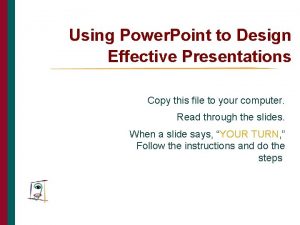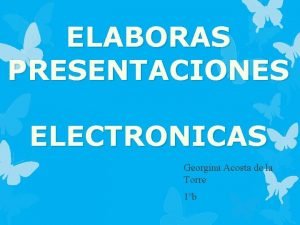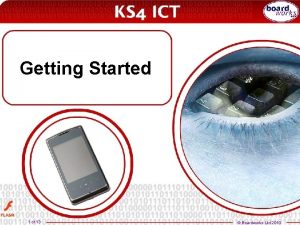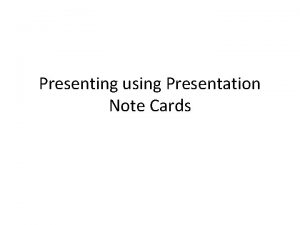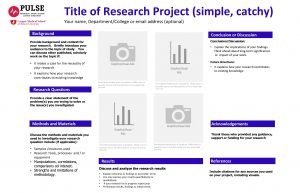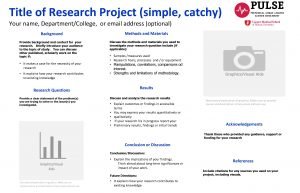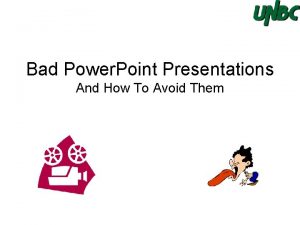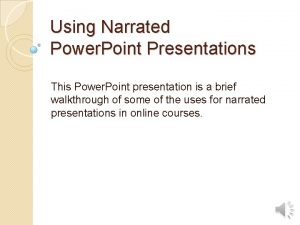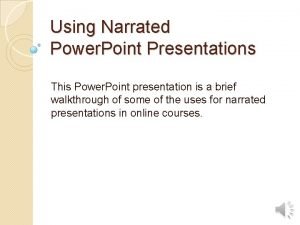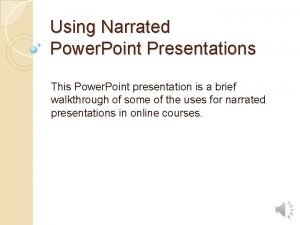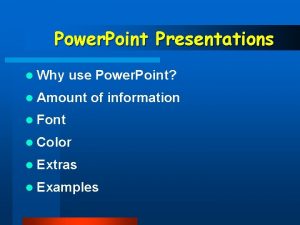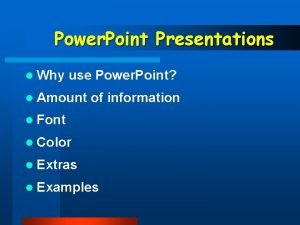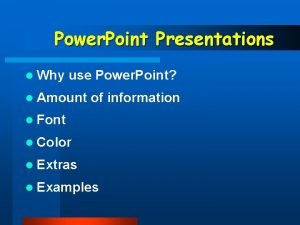Using Neuropsychology for Effective Power Point Presentations Aaron











































- Slides: 43

Using Neuropsychology for Effective Power. Point Presentations Aaron Michelfelder, M. D. , FAAFP, FAAMA Vice-Chair and Medical Student Education Director of Family Medicine Associate Professor of Family Medicine, and Bioethics & Health Policy

Roadmap • • Preparation General Principles Specific Power. Point Recommendations Presentation Tips

Preparation From “MDConsult: Preparing your infant for a test or procedure. ”

When preparing for a talk, do you search the internet specifically for other people’s Power. Point presentations?

Preparation • Research – Books, Articles, Internet – Find Other Power Points • www. google. com

General Principles

General Principles • Three Goals of an Effective Presentation: – Connect with your audience – Direct and hold attention – Promote understanding and learning From Kosslyn: “CLEAR and to THE POINT: 8 Psychological Principles for Compelling Power. Point Presentations. ”

Connect With Your Audience • #1 Principle of Relevance • #2 Principle of Appropriate Knowledge From Kosslyn: “CLEAR and to THE POINT: 8 Psychological Principles for Compelling Power. Point Presentations. ”

Direct and Hold Attention • #3 Principle of Salience • #4 Principle of Discriminability • #5 Principle of Perceptual Organization From Kosslyn: “CLEAR and to THE POINT: 8 Psychological Principles for Compelling Power. Point Presentations. ”

Promote Understanding & Learning • #6 Principle of Compatibility • #7 Principle of Informative Changes • #8 Principle of Capacity Limitations From Kosslyn: “CLEAR and to THE POINT: 8 Psychological Principles for Compelling Power. Point Presentations. ”

Specific Power. Point Rules From www. toolmonger. com

Which Slide Style Do You Prefer? • Studies of SSOM Students Show: – 91% are Brilliant – 62% Exercise Regularly – 96% Bathe Regularly – 41% Eat Regularly – 3% Get Most of Their Sleep at School 1

Which Slide Style Do You Prefer? • Studies of SSOM Students Show: – 91% are Brilliant – 62% Exercise Regularly – 96% Bathe Regularly – 41% Eat Regularly – 3% Get Most of Their Sleep at School 2

Backgrounds • People Generally Prefer: – In a Dark Room: • Dark Background • Light Letters – In a Light Room • Light Background • Dark Letters

Which do you prefer? • Purple Background with Yellow Letters Or • Green Background with Yellow Letters 1

Which do you prefer? • Purple Background with Yellow Letters Or • Green Background with Yellow Letters 2

Backgrounds • • • Cooler Colors Background Warmer Colors Content Simple Significant Contrast Avoid Patterns

Which Font Do You Prefer? • Studies Show of all SSOM Professors: – 89% are Funny – 21% are Geeks – 99. 1% are Attractive – 12% Sleep with the Lights on – 16% are Asleep right now 1

Which Font Do You Prefer? • Studies Show of all SSOM Professors: – 89% are Funny – 21% are Geeks – 99. 1% are Attractive – 12% Sleep with the Lights on – 16% are Asleep right now 2

Font • Ariel is Preferred – Simple Letters – Easy to Read from back of room • At Least 28 point

Content • 8 by 8 Rule – 8 lines of text – 8 -10 words per line • 8 Second Rule • 1 Slide per Minute

Graphs Versus Numbers • People Prefer Graphs to Tables • Graphs Should Use: – Complementary Colors Next To Each Other – Contrast to Make A Point

Power. Point Default Pie Chart Sales 1 st Qtr 2 nd Qtr 3 rd Qtr 4 th Qtr

From: www. infragistics. com


Clip Art Versus Photos

Animation • Animation is only to emphasize a point – Do not use it for every slide or word or line (unless you want your audience nauseated) – Power. Point default is medium animation – Speed up animation to very fast – (Now Isn’t this better!!) – (Do you believe me now? )

Animation • Studies Show: – People Want some Control Over Their Learning – Audiences Like to see All of The Content At Once – That Gives Them Some Control – Fade-in For Emphasis Only – Use Fade-in Sparingly

Sounds • Sounds for Emphasis Only • People Find Sounds on Every Line to be “Highly Irritating” Photo from: www. nordicroads. com

SAT Quiz The Screen is to the Presenter, as the (fill in the blank) is to the Audience.


Handouts • If I give them the Power Point Slides, then The Audience Can Take Notes As they Go – Audience Must Pay Attention – Audience May Miss Key Points – Copyright Issues – If Recorded, Will need to provide “Value-added” in talk • If I give the Audience a More Detailed Handout, then The Audience Can Pay More Attention to What I am Presenting. – Audience Doesn’t need to Pay attention to get the key points – Key Points are Never Missed – Will need to provide “Valueadded” in talk

Presentation Tips From: http: //www. lib. utsystem. edu/about/training/img 007. gif

Presentation Tips • Where do you Want the Focus? – On You and Your Words? – On Your Slides? – On Your Handout?

Presentation Tips • Avoid Apologies • Use Positive Statements – About the Audience – About the Material – About What the Audience Will Learn

Presentation Tips • Grab Attention Early • Think About Non-Verbal Communication – http: //www. youtube. com/watch? v=Bm. U 5 MO 7 Za. ZU

Presentation Tips • Show and Tell • Use Blank Screens • Insert a Break or Change Every 20 Minutes

Power. Point Karaoke

Value-Added • When Lectures are Recorded, What Can We Do to Make Sure Being Present Adds Value to the Learner Over Just Passive Watching From Home?

Goals of Presentation • Connect with your audience – #1 Principle of Relevance – #2 Principle of Appropriate Knowledge • Direct and hold attention – #3 Principle of Salience – #4 Principle of Discriminability – #5 Principle of Perceptual Organization From Kosslyn: “CLEAR and to THE POINT: 8 Psychological Principles for Compelling Power. Point Presentations. ”

Goals of Presentation (Con’t) • Promote understanding and learning – #6 Principle of Compatibility – #7 Principle of Informative Changes – #8 Principle of Capacity Limitations From Kosslyn: “CLEAR and to THE POINT: 8 Psychological Principles for Compelling Power. Point Presentations. ”

http: //www. youtube. com/watch? v=lpvgfm. EU 2 Ck

Thanks! Questions? -or. Comments?
 Neuropsychology in south africa
Neuropsychology in south africa Fundamentals of human neuropsychology
Fundamentals of human neuropsychology Fundamentals of human neuropsychology
Fundamentals of human neuropsychology Fundamentals of human neuropsychology
Fundamentals of human neuropsychology Broca vs wernicke
Broca vs wernicke Anterograde vs retrograde amnesia
Anterograde vs retrograde amnesia Kolb whishaw fundamentals of human neuropsychology
Kolb whishaw fundamentals of human neuropsychology Disadvantage of powerpoint presentation
Disadvantage of powerpoint presentation Power triangle formula
Power triangle formula Power bi training powerpoint
Power bi training powerpoint Point point power
Point point power Chapter 16 using effective promotions
Chapter 16 using effective promotions Effective isotropic radiated power
Effective isotropic radiated power Effective isotropic radiated power
Effective isotropic radiated power Effective power text copy
Effective power text copy The craft of scientific presentations
The craft of scientific presentations Introduction to mental health awareness presentation
Introduction to mental health awareness presentation Bad slide examples
Bad slide examples To maintain audience interest in a multimedia presentation
To maintain audience interest in a multimedia presentation Slidetodoc
Slidetodoc Ventajas y desventajas de corel presentations
Ventajas y desventajas de corel presentations Designing and delivering oral and online presentations
Designing and delivering oral and online presentations What are the three major types of verbal support
What are the three major types of verbal support Tok presentations
Tok presentations World's worst presentation
World's worst presentation Business presentations bristol
Business presentations bristol Ria seminar presentations
Ria seminar presentations Boardworks ltd
Boardworks ltd Scqa analysis
Scqa analysis Internet presentations
Internet presentations The most dangerous game ppt
The most dangerous game ppt Note card for presentation
Note card for presentation The end pictures for presentations
The end pictures for presentations Useful phrases presentation
Useful phrases presentation Efficient elements download
Efficient elements download You exec presentations
You exec presentations Catchy titles for science projects
Catchy titles for science projects Research project title
Research project title Robotics merit badge powerpoint
Robotics merit badge powerpoint Customer service presentations
Customer service presentations Switch stacking concept
Switch stacking concept Bad powerpoint presentations examples
Bad powerpoint presentations examples Breaking bad powerpoint template
Breaking bad powerpoint template You exec presentations
You exec presentations














